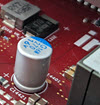 Yesterday, I had the honor of being the opponent at the PhD defense of Simon Kågström at Blekinge Tekniska Högskola (BTH, Blekinge University of Technology in English). His PhD thesis deals mainly with the multiprocessor port of an industrial in-house operating system, and a secondary theme was the design of the Cibyl C-programs-to-JVM translator. All of his papers are very well-written and a joy to read, and the engineering work behind it is very solid.
Yesterday, I had the honor of being the opponent at the PhD defense of Simon Kågström at Blekinge Tekniska Högskola (BTH, Blekinge University of Technology in English). His PhD thesis deals mainly with the multiprocessor port of an industrial in-house operating system, and a secondary theme was the design of the Cibyl C-programs-to-JVM translator. All of his papers are very well-written and a joy to read, and the engineering work behind it is very solid.
The most important data in the PhD thesis is really just how much work it is to do an SMP port of an OS kernel. And how hard it is to get performance up to good levels even with several years of work. Really emphasizes the point that hard work and perseverance and just lots of calendar time is what it takes to create a good SMP OS. That’s why Solaris and AIX are still years ahead of Linux in this respect — you just need to hit the snags, fix them, retest, and hit the next snag. It takes time to polish, basically.
So, if you have any interest in multiprocessor operating systems, Simon’s work is well-worth a read. Also check out his blog at http://simonkagstrom.livejournal.com/. And by the way, he did pass.


 Traditional hardware design languages like
Traditional hardware design languages like 
 I have another short technical piece published about
I have another short technical piece published about  Yesterday, I had the honor of being the opponent at the PhD defense of
Yesterday, I had the honor of being the opponent at the PhD defense of 